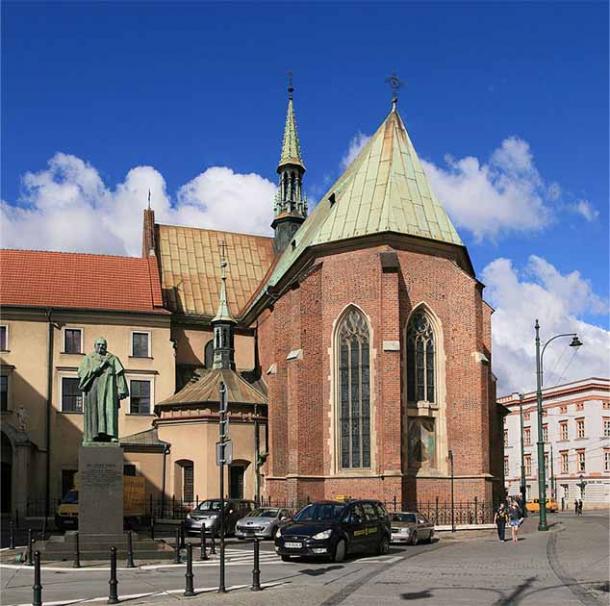300 Year Old “Exceptional” Prosthesis made of Gold and Copper Discovered in Poland

Polish archaeologists working on excavations at the Church of St. Francis of Assisi in Krakow have discovered something new, described as the first discovery of its kind in the country. A man’s body has been revealed to have a medical prosthesis in his mouth, an artificial insert that allowed him to live with a cleft palate.
Anna Spinek, an anthropologist at the Hirszfeld Institute of Immunology and Experimental Therapy in Poland, explained this discovery to Live Science. “This is probably the first discovery of this type, not only in Poland but also in Europe. No such device exists in institutional and private collections (Polish and foreign).”
The prosthetic device before and after conservation, seen from the side. The area marked “a” is gold and “b” is copper residue. The bulbous “c” is a wool pad and the concave flat “e” is the plate underneath that replaces the hard palate, attached by the string “d” (Marcin Nowak, Magdalena Śliwka-Kaszyńska; © 2024 Elsevier Ltd / Science Live)
The device, described as a palatal obturator, was designed to fit into the man’s palate. It would fit into the man’s nasal cavity, replacing his hard palate.
A finely designed device
A cleft palate occurs during gestation when the palate, especially the hard palate, does not close completely. As a result, the nasal cavity is directly connected to the mouth and foreign substances can enter this cavity. A cleft palate usually leads to problems associated with breathing, speaking, and eating.
The authors note in their article that the first attempts to replace the missing parts of the palace probably date back to ancient times. The Greek orator Demosthenes (384 – 322 BC) suffered from a congenital cleft palate and may have used pebbles to fill open spaces inside his mouth.
Cleft palates are resolved today through relatively simple surgical procedures, but this was not possible for humans 300 years ago. Instead, he found another solution: this device, which was inserted into his mouth like a prosthesis.

The prosthesis made of gold, silver and copper was discovered in a crypt of the Church of Saint Francis of Assisi, in Krakow, Poland (Ludvig14 / CC BY-SA 3.0)
The device itself, described as “exceptional”, is made up of two parts. A metal plate mimicking the hard palate is attached to a wool pad, designed to comfortably secure the device when placed in the mouth.
When removing the wool pad, small particles of yellow and green material were observed, which researchers believe are traces of gold and copper. It appears that the plaque was covered with a thin layer of copper, then gold, to provide a barrier and prevent infection by preventing the absorption of secretions from the nasal cavity.
The tampon also appears to have had a coating of copper and gold to prevent infection. The prosthesis is overall concave in shape and designed to curve into the nasal cavity, leaving a hollow in the mouth, just like a natural hard palate would.
To better understand the composition of the prosthesis, the researchers analyzed it using a scanning electron microscope and X-ray spectroscopy, which analyzes the chemical composition of a sample. They discovered that the metal pieces were indeed made largely of copper, with considerable amounts of gold and silver.
The wool was also analyzed and contained traces of silver iodide. It is likely that this was added to the tampon for its antimicrobial properties.
The shutter had initially been observed during excavations of the crypt containing the man between 2017 and 2018, where it remained largely where it should be between the body’s skeletal jaws. However, despite further analysis, it is not yet possible to determine how well the prosthesis actually worked.
“Today, it is difficult to assess the quality of the shutter or the seal it provides,” the authors write in their article. “However, today’s patients with similar health problems describe the use of a prosthesis providing improved speech (becoming clearer) and increased comfort when eating.”
Top image: The man’s skull found from behind in Poland. On the left, the absence of a hard palate is clearly visible. The photograph on the right shows how the gold prosthesis was placed. Source: Anna Spinek; © 2024 Elsevier Ltd / Science Live.
By Joseph Green
News Source : www.ancient-origins.net
Gn Health





